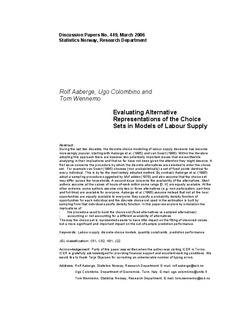| dc.contributor.author | Aaberge, Rolf | |
| dc.contributor.author | Colombino, Ugo | |
| dc.contributor.author | Wennemo, Tom | |
| dc.date.accessioned | 2011-11-21T12:12:07Z | |
| dc.date.available | 2011-11-21T12:12:07Z | |
| dc.date.issued | 2006 | |
| dc.identifier.issn | 1892-753x | |
| dc.identifier.uri | http://hdl.handle.net/11250/180245 | |
| dc.description.abstract | Abstract:
During the last two decades, the discrete-choice modelling of labour supply decisions has become
increasingly popular, starting with Aaberge et al. (1995) and van Soest (1995). Within the literature
adopting this approach there are however two potentially important issues that are worthwhile
analyzing in their implications and that so far have not been given the attention they might deserve. A
first issue concerns the procedure by which the discrete alternatives are selected to enter the choice
set. For example van Soest (1995) chooses (non probabilistically) a set of fixed points identical for
every individual. This is by far the most widely adopted method. By contrast, Aaberge et al. (1995)
adopt a sampling procedure suggested by McFadden (1978) and also assume that the choice set
may differ across the households. A second issue concerns the availability of the alternatives. Most
authors assume all the values of hours-of-work within some range [0, H] are equally available. At the
other extreme, some authors assume only two or three alternatives (e.g. non-participation, part-time
and full-time) are available for everyone. Aaberge et al. (1995) assume instead that not all the hour
opportunities are equally available to everyone; they specify a probability density function of
opportunities for each individual and the discrete choice set used in the estimation is built by
sampling from that individual-specific density function. In this paper we explore by simulation the
implications of
- the procedure used to build the choice set (fixed alternatives vs sampled alternatives)
- accounting or not accounting for a different availability of alternatives.
The way the choice set is represented seems to have little impact on the fitting of observed values,
but a more significant and important impact on the out-of-sample prediction performance.
Keywords: Labour supply, discrete-choice models, quantity constraints, prediction performance | no_NO |
| dc.language.iso | eng | no_NO |
| dc.publisher | Statistics Norway, Research Department | no_NO |
| dc.relation.ispartofseries | Discussion Papers;No. 449 | |
| dc.subject | Labour supply | no_NO |
| dc.subject | Discrete-choice models | no_NO |
| dc.subject | Prediction performance | no_NO |
| dc.subject | JEL classification: C51 | no_NO |
| dc.subject | JEL classification: C52 | no_NO |
| dc.subject | JEL classification: H31 | no_NO |
| dc.subject | JEL classification: J22 | no_NO |
| dc.title | Evaluating alternative representations of the choice sets in models of labour supply | no_NO |
| dc.type | Working paper | no_NO |
| dc.subject.nsi | VDP::Social science: 200::Economics: 210::Economics: 212 | no_NO |
| dc.source.pagenumber | 29 s. | no_NO |
